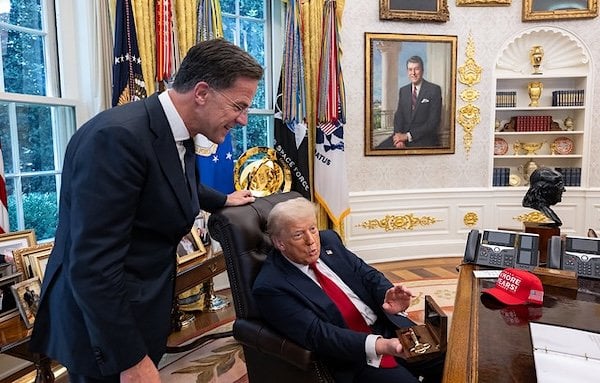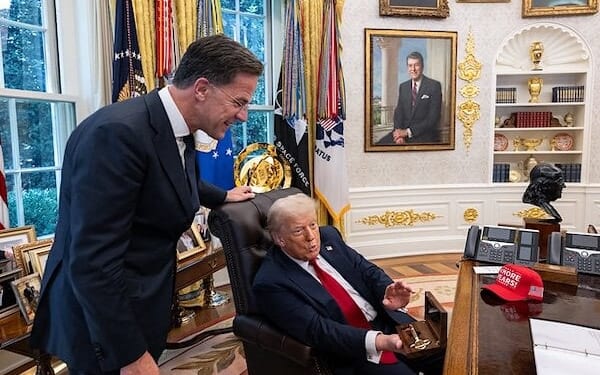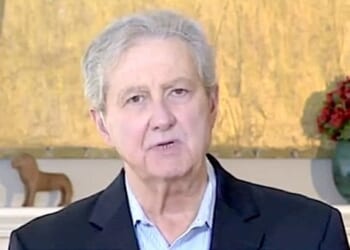
Since its birth in 1949, the North Atlantic Treaty Organization (NATO) has been attached to the United States by a figurative umbilical cord which has sustained its life well into old age—76 years. As the Trump administration restructures the American armed forces by instituting a 10-point plan announced at the recent meeting of the generals and flag officers at Quantico, by renaming the Department of Defense the War Department, by reinvigorating our industrial plant to build more ships, planes, and other war platforms, by modernizing our nuclear forces, by pursuing Golden Dome defenses, and by redirecting the focus of our armed forces to protecting the homeland and securing the Western Hemisphere, the long-delayed need to emancipate our European allies into global adulthood is upon us. It is time for the United States to cut NATO’s umbilical cord.
Cutting NATO’s umbilical cord does not mean wholly withdrawing from the alliance or retreating into isolationism. When a mother’s umbilical cord is separated from her baby, she doesn’t stop caring for the baby and nurturing the child, and often continues to support and protect the child as the child becomes a young adult. But there comes a time when the young adult matures and reaches full adulthood and needs to stand on his or her own two feet. That process doesn’t end the relationship, but it changes it. The emancipated adult mostly takes care of himself or herself and begins extending support and protection to their own families. NATO is 76 years old, but continues to act as a young adult, and sometimes acts like a child, always looking to the United States for financial and military support. That has to end. The Trump administration is ending it.
NATO’s umbilical cord should have been cut long ago. NATO’s first supreme commander Dwight Eisenhower said in 1951 that “If in 10 years, all American troops stationed in Europe for national defense purposes have not been returned to the United States, then this whole project will have failed.” U.S. troops are still there, and now they are committed to fighting on behalf of 31 other countries. NATO’s first Secretary General Lord Hastings Ismay famously remarked that the purpose of the alliance was “to keep the Soviet Union out, the Americans in, and the Germans down.” The Soviet Union hasn’t existed since 1991. Germany threatens no one. But the Americans are still “in” despite the fact that the European Union’s gross domestic product is nearly 70 percent of the U.S. gross domestic product.
Restructuring NATO appears to be one aspect of the forthcoming National Defense Strategy (NDS) as foreshadowed in War Secretary Pete Hegseth’s statement of May 2, 2025. Secretary Hegseth outlined three priorities for the NDS: defense of the homeland, deterring China in the Indo-Pacific, and burden-sharing with our allies and partners throughout the world. Burden-sharing includes most especially NATO. Under Secretary for Policy Elbridge Colby is heading-up the NDS, just as he did in Trump’s first term. Colby’s 2018 NDS shifted the department’s focus from small peripheral wars to great power competition, especially with China. Colby also has expressed concern that wars in the Middle East and Ukraine have distracted American policymakers from the greater threat in the Indo-Pacific. Trump’s Middle East peace proposals, efforts to end the Ukraine War, and repeated calls for greater burden-sharing by our European allies fit neatly within the forthcoming NDS as projected by Hegseth.
The forthcoming 2025 NDS, however, will refocus the War Department on protecting the homeland and securing the Western Hemisphere as part of Trump’s America First foreign policy. This approach has already manifested itself in sealing the nation’s southern border, mass deportations of illegal aliens, a renewed interest in controlling the Panama Canal, talk about acquiring Greenland, dispatching National Guard troops to combat crime in major cities, and using the armed forces to attack narco-terrorists in the Caribbean Sea. Trump has reinvigorated the Monroe Doctrine, which the Obama-Biden administrations treated as a historical relic of a distant past.
Trump’s approach to defense strategy is geographical and has strong historical precedents. It begins with homeland and hemispheric defense and then prioritizes U.S. interests in Eurasia by seeking to shift resources from the Middle East and Europe to the Indo-Pacific. It has elements of Washington’s Farewell Address by abjuring permanent and sentimental alliances. It echoes James Monroe’s and John Quincy Adams’ focus on hemispheric defense. It mirrors Theodore Roosevelt’s “big stick” diplomacy. Its burden-sharing efforts are reminiscent of the Nixon Doctrine. Finally, it recalls Ronald Reagan’s approach of peace through strength.
The 2025 NDS will not be isolationist or limited to hemispheric defense, as some critics claim. The Trump administration’s key national security personnel understand that, as Nicholas Spykman pointed out in America’s Strategy in World Politics, “hemispheric defense is no defense at all.” But they also understand that failing to protect the homeland and secure the Western Hemisphere would cripple our ability to project power abroad when it is in our interests to do so. The 2025 NDS will focus on geographical interests rather than “values.” The U.S. armed forces should fight for concrete security interests, not for “democracy.”
The Trump administration’s approach to the NDS and NATO received (surprising) support in the pages of Foreign Affairs. Jennifer Kavanagh of Georgetown’s Center for Security Studies and Peter Slezkine of the Stimson Center applaud Trump for seeking to rebalance the transatlantic relationship. Our NATO burden, they write, “is out of proportion with the interests at stake.” The U.S., they continue, should not carry most of the “operational and logistical burden for Europe’s security.” Europe should not be militarily dependent on the United States.
Kavanaugh and Slezkine agree with Trump’s refocus on the Western Hemisphere and counsel “pulling back from Europe and “avoiding the hard ‘pivot to Asia.’” NATO, they continue,” should “confine its activities to the Euro-Atlantic region” instead of “going global” in search of new missions after the fall of the Soviet Union. After the Second World War, the Atlanticists running U.S. foreign policy prioritized Europe over the Americas. They cite George Kennan for the proposition that America should not need to indefinitely provide security for Western Europe. Like Kennan did, Kavanaugh and Slezkine criticize NATO enlargement as unnecessary and provocative. Also, like Kennan, they are critical of the internationalists’ scheme to promote democracy throughout the world.
Kavanaugh and Slezkine urge Trump to carry out a “retrenchment” of U.S. forces in Europe and to “narrow the scope of the U.S. military commitment to Europe in a crisis.” There is no longer a need for U.S. soldiers to be on the frontlines in Europe. As in Ukraine, Trump should reduce the “risk of entanglement and the temptation U.S. policymakers might feel to support direct involvement.” The top civilian and military positions in NATO should be filled by Europeans, not Americans.
Kavanaugh and Slezkine also urge Trump to avoid a strong pivot to Asia as recommended by so-called “China hawks” within the administration. Instead, they argue, the U.S. should “pivot home” by focusing on the Western Hemisphere, border security, missile defense, and port security. Their proposed “pivot home” will surely be part of the 2025 NDS, but they may be too sanguine about the threat posed by China to our interests in the Indo-Pacific.
NATO was an important alliance, but as currently structured it has outlived its usefulness. Europe can stand on its own two feet without being tethered to the U.S. umbilical cord. Seventy-six years as a dependent is enough.
Francis P. Sempa writes on global affairs.
This article was originally published by RealClearWorld and made available via RealClearWire.








